- Accueil
- Pages cachées
- 08 JANVIER 2024 NEWS
08 JANVIER 2024 NEWS
INSTITUT SUPERIEUR D'ANTHROPOLOGIE
INSTITUT OF ANTHROPOLOGY
COURS ONLINE – COURS A DISTANCE
INSCRIPTIONS OUVERTES
REGISTER NOW
ITALIE – 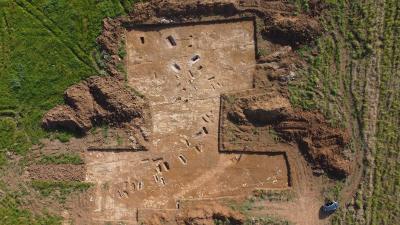
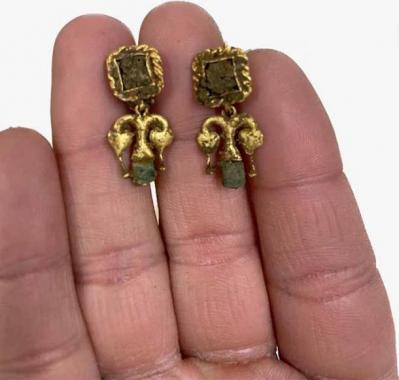 Tarquinia, - Archaeologists involved in a two-year-long excavation project at the site of a planned solar energy plant ancient city of Tarquinia, north of Rome, have unearthed an ancient Roman necropolis containing 67 skeletons buried in 57 ornate tombs. Early testing suggests the tombs and their occupants date back to the second through fourth centuries AD. This cemetery was undoubtedly reserved for wealthy and powerful Roman elites. The well-preserved skeletons were dressed in gold jewelry and fancy leather footwear, and their tombs appear to have been designed to resemble the architecture of their earthly homes (smaller in scale). “We found several skeletons still wearing their expensive stockings and shoes,” lead excavation archaeologist Emanuele Giannini, who works for the private archaeological firm Eos Arc, told CNN. “All these riches, and the fact that the bones show no sign of stress or physical labor, [leads us to believe] these weren’t local farmers, but upper-crust members of Roman families coming from cities.” Although the region is known for such finds, the discovery, which took place on a 52-acre plot of land near the ancient city of Tarquinia, north of Rome, surprised the authorities. They simply had no idea that a cemetery reserved for aristocrats would have been located where it was, given the lack of any historical reference. The collection of luxurious goods buried with the deceased individuals was extremely impressive. Among the highlights were silver rings with amber and engraved initials, amulets containing precious stones, many pieces of terracotta pottery, Roman coins of different values, shiny glass objects, and even some still-preserved items of clothing. Archaeologists believe that the occupants wanted to recreate heavenly spaces similar to their earthly homes based on the diversity of funerary objects found near the remains and the luxurious designs and linings inside the tombs. Many tombs used to have elaborate cloth linings or were surrounded and covered by tiles or terracotta pieces that looked like little houses. The skeletal remains were found very close to the surface of the earth, buried at a depth of approximately 20 inches (50 cm). Most of the discovered graves were communal graves, probably built for at least two people who shared the same family connection. Several skeletons were also found wrapped together.
Tarquinia, - Archaeologists involved in a two-year-long excavation project at the site of a planned solar energy plant ancient city of Tarquinia, north of Rome, have unearthed an ancient Roman necropolis containing 67 skeletons buried in 57 ornate tombs. Early testing suggests the tombs and their occupants date back to the second through fourth centuries AD. This cemetery was undoubtedly reserved for wealthy and powerful Roman elites. The well-preserved skeletons were dressed in gold jewelry and fancy leather footwear, and their tombs appear to have been designed to resemble the architecture of their earthly homes (smaller in scale). “We found several skeletons still wearing their expensive stockings and shoes,” lead excavation archaeologist Emanuele Giannini, who works for the private archaeological firm Eos Arc, told CNN. “All these riches, and the fact that the bones show no sign of stress or physical labor, [leads us to believe] these weren’t local farmers, but upper-crust members of Roman families coming from cities.” Although the region is known for such finds, the discovery, which took place on a 52-acre plot of land near the ancient city of Tarquinia, north of Rome, surprised the authorities. They simply had no idea that a cemetery reserved for aristocrats would have been located where it was, given the lack of any historical reference. The collection of luxurious goods buried with the deceased individuals was extremely impressive. Among the highlights were silver rings with amber and engraved initials, amulets containing precious stones, many pieces of terracotta pottery, Roman coins of different values, shiny glass objects, and even some still-preserved items of clothing. Archaeologists believe that the occupants wanted to recreate heavenly spaces similar to their earthly homes based on the diversity of funerary objects found near the remains and the luxurious designs and linings inside the tombs. Many tombs used to have elaborate cloth linings or were surrounded and covered by tiles or terracotta pieces that looked like little houses. The skeletal remains were found very close to the surface of the earth, buried at a depth of approximately 20 inches (50 cm). Most of the discovered graves were communal graves, probably built for at least two people who shared the same family connection. Several skeletons were also found wrapped together.
ROUMANIE – 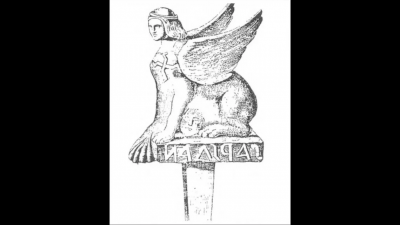 - The bronze sphinx statue, dating to the third century, was discovered in Dacia, a Roman province corresponding to modern-day Romania. However, after being discovered in the 19th century, the statue was stolen from a European count sometime around 1848. While the sphinx was never found, a detailed drawing of it survived. Dacia is the ancient name for Romania and has seen the rule of various groups and empires throughout history. During ancient times, Dacia was part of the Dacian Kingdom and later became a province of the Roman Empire after its conquest by Roman Emperor Trajan in AD 106. However, in the 3rd century, invasions by the Goths and other tribes weakened Roman control, and around 270 AD, the Romans withdrew from Dacia. Subsequently, Dacia came under the rule of various tribes and empires. The inscription on the sphinx has finally been deciphered, revealing a short but “unusual” poem, according to a study published Dec. 30 in the journal Mediterranean Archeology and Archaeometry. It was determined that the inscription around the base of a bronze sphinx statue was written using the archaic Greek alphabet. However, the Greek alphabet phonetic values render a text that is non-sensical in the Greek language. Therefore, the meaning of the inscription has puzzled scholars since the artifact’s discovery in the early 19th century. Researchers were unsuccessful, possibly because it reads from left to right, which is a “unusual” departure from ancient norms. The scribe was most likely attempting to express something in a language other than Greek by employing an archaic Greek alphabet. The phonetic values of the archaic Greek alphabet record a short rhythmic poem in Proto-Hungarian. Translated into English, it reads: “Lo, behold, worship: here is the holy lion,” which can be perceived as a command to venerate the sphinx. “The characters may seem mysterious at first, but once the mirroring is noticed, the characters become easily recognizable as Greek alphabet letters, a few of them being in a more archaic form,” Peter Revesz, the study author and professor at the University of Nebraska, told McClatchy News. The decoded poem is noteworthy because “the sphinx cult was not part of the mainstream ancient Roman mythology which features the Roman gods and goddesses that many people today are familiar with,” Revesz said. Revesz emphasized that this sphinx statue is unique in that it provides some records of a minority religion for which records in the Roman Empire are much less numerous.
- The bronze sphinx statue, dating to the third century, was discovered in Dacia, a Roman province corresponding to modern-day Romania. However, after being discovered in the 19th century, the statue was stolen from a European count sometime around 1848. While the sphinx was never found, a detailed drawing of it survived. Dacia is the ancient name for Romania and has seen the rule of various groups and empires throughout history. During ancient times, Dacia was part of the Dacian Kingdom and later became a province of the Roman Empire after its conquest by Roman Emperor Trajan in AD 106. However, in the 3rd century, invasions by the Goths and other tribes weakened Roman control, and around 270 AD, the Romans withdrew from Dacia. Subsequently, Dacia came under the rule of various tribes and empires. The inscription on the sphinx has finally been deciphered, revealing a short but “unusual” poem, according to a study published Dec. 30 in the journal Mediterranean Archeology and Archaeometry. It was determined that the inscription around the base of a bronze sphinx statue was written using the archaic Greek alphabet. However, the Greek alphabet phonetic values render a text that is non-sensical in the Greek language. Therefore, the meaning of the inscription has puzzled scholars since the artifact’s discovery in the early 19th century. Researchers were unsuccessful, possibly because it reads from left to right, which is a “unusual” departure from ancient norms. The scribe was most likely attempting to express something in a language other than Greek by employing an archaic Greek alphabet. The phonetic values of the archaic Greek alphabet record a short rhythmic poem in Proto-Hungarian. Translated into English, it reads: “Lo, behold, worship: here is the holy lion,” which can be perceived as a command to venerate the sphinx. “The characters may seem mysterious at first, but once the mirroring is noticed, the characters become easily recognizable as Greek alphabet letters, a few of them being in a more archaic form,” Peter Revesz, the study author and professor at the University of Nebraska, told McClatchy News. The decoded poem is noteworthy because “the sphinx cult was not part of the mainstream ancient Roman mythology which features the Roman gods and goddesses that many people today are familiar with,” Revesz said. Revesz emphasized that this sphinx statue is unique in that it provides some records of a minority religion for which records in the Roman Empire are much less numerous.
‘Mysterious’ inscription on ancient Dacia sphinx is deciphered - Arkeonews
ESPAGNE – 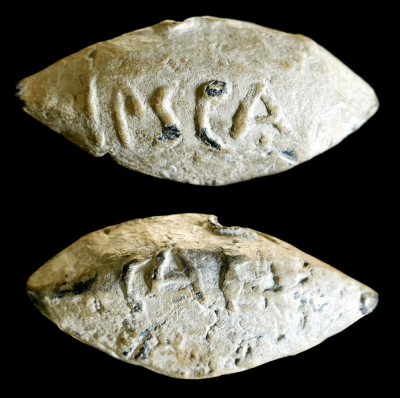 Montilla - A lead sling bullet inscribed with the name of Julius Caesar and the Ibero-Roman city Ipsca has been discovered in the countryside of Montilla, Andalusia, southern Spain. It is the first time in the Iberian Peninsula that an incontrovertible inscription of Gaius Julius Caesar’s name abbreviated with CAES has been discovered on this type of projectile. It is also the first sling bullet inscribed with the place name Ipsca; in fact, it is the first toponym of any Roman Hispania city ever found inscribed on a sling bullet. The discovery was possible thanks to the in-depth study of the projectile conducted by Javier Moralejo and Jesúss Robles of the Autonomous University of Madrid, together with Antonio Moreno of the Archaeological Museum of Cabra and José Antonio Morena of the Museo Histórico of Baena. Their work has now been published in the scientific journal Zephyrus of the University of Salamanca. The lead sling bullet was found 19 kilometers from Baena, in the countryside of Montilla, a Spanish municipality of around 23 thousand inhabitants, located in the autonomous community of Andalusia. The town is located at an average height of 372 meters above sea level and 49 kilometers from Cordoba. The terrible final clash of the civil war probably took place in his campaigns – the battle of Munda – which brought Julius Caesar here against the sons of Pompey, in 45 BC. In 45 B.C., Julius Caesar and Pompey’s surviving sons, Gnaeus and Sextus Pompeius, fought the final battle of their civil war in the countryside. The exact location of the Battle of Munda has long been debated, with the Montilla area being one of the leading contenders. The discovery of the lead sling bullet supports this candidacy and confirms Ipsca’s alliance with Caesar’s faction. The bullet is shaped like an acorn, with pointed ends. It measures 4.5 centimeters long, 2 centimeters wide and 1.7 centimeters high. It weighs 71.1 grams. And it bears two inscriptions, in relief: IPSCA ve CAES. Inscriptions on lead slingshot projectiles (glandes inscriptae) were first used in the 5th century B.C. Greece and continued through the early Roman imperial era. The clay molds used to manufacture the shots would be incised so the projectile, once hardened, would feature an inscription in relief on the body Inscriptions commonly included the maker’s name, the military commander, the legion, or the location where they were to be deployed. Throughout history, the sling gained popularity as a weapon in Ancient Greece and the Roman era. The Roman Army even adopted slings for use by their skirmishers. A tiny hand-powered projectile weapon called a sling, which has a small cradle or pouch between two retention cords, fired the bullet.
Montilla - A lead sling bullet inscribed with the name of Julius Caesar and the Ibero-Roman city Ipsca has been discovered in the countryside of Montilla, Andalusia, southern Spain. It is the first time in the Iberian Peninsula that an incontrovertible inscription of Gaius Julius Caesar’s name abbreviated with CAES has been discovered on this type of projectile. It is also the first sling bullet inscribed with the place name Ipsca; in fact, it is the first toponym of any Roman Hispania city ever found inscribed on a sling bullet. The discovery was possible thanks to the in-depth study of the projectile conducted by Javier Moralejo and Jesúss Robles of the Autonomous University of Madrid, together with Antonio Moreno of the Archaeological Museum of Cabra and José Antonio Morena of the Museo Histórico of Baena. Their work has now been published in the scientific journal Zephyrus of the University of Salamanca. The lead sling bullet was found 19 kilometers from Baena, in the countryside of Montilla, a Spanish municipality of around 23 thousand inhabitants, located in the autonomous community of Andalusia. The town is located at an average height of 372 meters above sea level and 49 kilometers from Cordoba. The terrible final clash of the civil war probably took place in his campaigns – the battle of Munda – which brought Julius Caesar here against the sons of Pompey, in 45 BC. In 45 B.C., Julius Caesar and Pompey’s surviving sons, Gnaeus and Sextus Pompeius, fought the final battle of their civil war in the countryside. The exact location of the Battle of Munda has long been debated, with the Montilla area being one of the leading contenders. The discovery of the lead sling bullet supports this candidacy and confirms Ipsca’s alliance with Caesar’s faction. The bullet is shaped like an acorn, with pointed ends. It measures 4.5 centimeters long, 2 centimeters wide and 1.7 centimeters high. It weighs 71.1 grams. And it bears two inscriptions, in relief: IPSCA ve CAES. Inscriptions on lead slingshot projectiles (glandes inscriptae) were first used in the 5th century B.C. Greece and continued through the early Roman imperial era. The clay molds used to manufacture the shots would be incised so the projectile, once hardened, would feature an inscription in relief on the body Inscriptions commonly included the maker’s name, the military commander, the legion, or the location where they were to be deployed. Throughout history, the sling gained popularity as a weapon in Ancient Greece and the Roman era. The Roman Army even adopted slings for use by their skirmishers. A tiny hand-powered projectile weapon called a sling, which has a small cradle or pouch between two retention cords, fired the bullet.
Lead sling bullet inscribed with “Julius Caesar” name found in Spain - Arkeonews
TURQUIE – 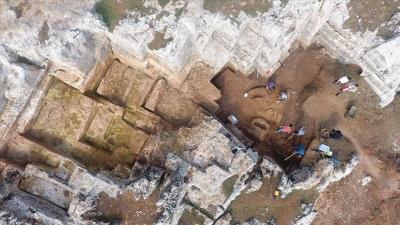
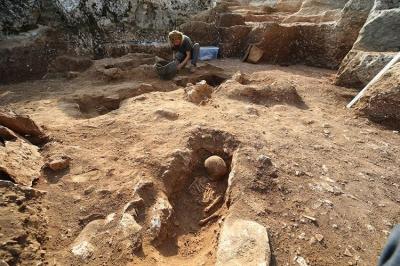 Diyarbakır - During the archaeological excavation carried out in the area considered to be an old quarry in the Kulp district of Diyarbakır in southeastern Turkey, a cemetery where 54 children between the ages of 0-6 were buried was unearthed. Following the discovery of coins belonging to the Byzantine Emperor Anastasius I in the surface survey conducted in different areas in İnkaya Neighborhood, the excavations started After the discovery of the remains of a 1500-year-old church last year, excavation works commenced in the area considered to be an ancient quarry. The teams encountering the children’s graves during the excavations intensified their efforts in this area. Probably after this place was used as a quarry, it was turned into a necropolis (a cemetery, belonging to an ancient city), and only children were buried here Stating that they found that more than one child was buried in some graves, Gizligöl said, “A limestone cist was formed around the graves and closed with limestone. The graves are in the east-west direction, there is no random burial.” Church ruins were found in previous excavations in the area and stated that the church dates to the early Byzantine Period and approximately 1500 years ago. Akbaş said the following about the detection of graves in the church: “Since there was a ‘saint’ and ‘martyr’ culture in early Byzantium, in-settlement burials can occur in churches. In this area, which we call the quarry, only graves belonging to infants and children between the ages of 0 and 6 were found.” Stating that, based on the preliminary examination, they do not think that the babies and children died due to any epidemic, Akbaş stated that a detailed skeletal study has not been carried out yet. “We think that the burial of babies in the area in question is related to the baptismal culture of Christianity in the early Byzantine period. In the early Christian period, those who were baptized were generally adults. After the 10th century, it became legal that children should be baptized. We think that these belong to the early Christian period. Therefore, babies and children who have not been baptized, that is, who are not yet Christians. Since he was not baptized, we are considering the possibility of him being buried outside the church rather than inside it.” The researcher drew attention to an example of a grave in which only children were buried in the Amorium excavations in Afyonkarahisar. He said that during the Amorium excavations, it was revealed that only babies and children were buried in a certain area of the cemetery dating back to the 10th and 11th centuries, and a baptistery was detected near the cemetery, but no baptistery was found yet in the excavations in Kulp.
Diyarbakır - During the archaeological excavation carried out in the area considered to be an old quarry in the Kulp district of Diyarbakır in southeastern Turkey, a cemetery where 54 children between the ages of 0-6 were buried was unearthed. Following the discovery of coins belonging to the Byzantine Emperor Anastasius I in the surface survey conducted in different areas in İnkaya Neighborhood, the excavations started After the discovery of the remains of a 1500-year-old church last year, excavation works commenced in the area considered to be an ancient quarry. The teams encountering the children’s graves during the excavations intensified their efforts in this area. Probably after this place was used as a quarry, it was turned into a necropolis (a cemetery, belonging to an ancient city), and only children were buried here Stating that they found that more than one child was buried in some graves, Gizligöl said, “A limestone cist was formed around the graves and closed with limestone. The graves are in the east-west direction, there is no random burial.” Church ruins were found in previous excavations in the area and stated that the church dates to the early Byzantine Period and approximately 1500 years ago. Akbaş said the following about the detection of graves in the church: “Since there was a ‘saint’ and ‘martyr’ culture in early Byzantium, in-settlement burials can occur in churches. In this area, which we call the quarry, only graves belonging to infants and children between the ages of 0 and 6 were found.” Stating that, based on the preliminary examination, they do not think that the babies and children died due to any epidemic, Akbaş stated that a detailed skeletal study has not been carried out yet. “We think that the burial of babies in the area in question is related to the baptismal culture of Christianity in the early Byzantine period. In the early Christian period, those who were baptized were generally adults. After the 10th century, it became legal that children should be baptized. We think that these belong to the early Christian period. Therefore, babies and children who have not been baptized, that is, who are not yet Christians. Since he was not baptized, we are considering the possibility of him being buried outside the church rather than inside it.” The researcher drew attention to an example of a grave in which only children were buried in the Amorium excavations in Afyonkarahisar. He said that during the Amorium excavations, it was revealed that only babies and children were buried in a certain area of the cemetery dating back to the 10th and 11th centuries, and a baptistery was detected near the cemetery, but no baptistery was found yet in the excavations in Kulp.
ANGLETERRE – 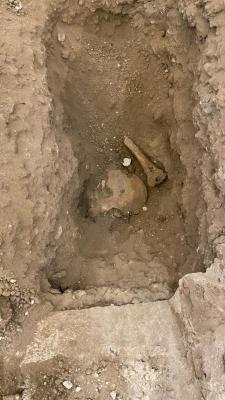 Prittlewell, - St Mary’s Church in East Street, Prittlewell, is believed to be the biggest and oldest church in the whole Southend borough and underwent £70,000 works to remove pews last year. However, during the work a series of “ancient treasures” were uncovered, including the 13 intact burials, fossils and Roman tiles. The oldest remains are said to pre-date the Norman foundations under which they were buried, making them at least 1,000 years old. Along with the burials, archaeologists uncovered 300-million-year-old fossils, Roman tiles,
Prittlewell, - St Mary’s Church in East Street, Prittlewell, is believed to be the biggest and oldest church in the whole Southend borough and underwent £70,000 works to remove pews last year. However, during the work a series of “ancient treasures” were uncovered, including the 13 intact burials, fossils and Roman tiles. The oldest remains are said to pre-date the Norman foundations under which they were buried, making them at least 1,000 years old. Along with the burials, archaeologists uncovered 300-million-year-old fossils, Roman tiles,
Prittlewell St Mary's Church 11th century burials found | Echo (echo-news.co.uk)
ITALIE – 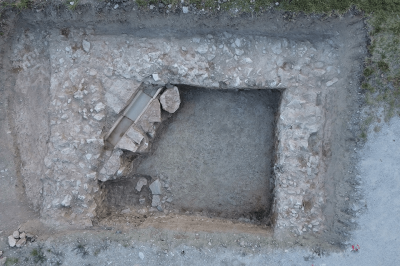 Spello - American researchers have announced the discovery of an Imperial cult temple in Spello, . The temple was discovered during excavations in Spello, an ancient hilltop town located more than 70 miles north of Rome. The structure is thought to have been built in the fourth century during the reign of Emperor Constantine, who ruled Rome from A.D. 306 to A.D. 337. Constantine was the first Roman emperor to convert to Christianity. Their findings offer a profound glimpse into a time of cultural and religious flux, revealing a society that was more “multicultural” than previously thought. A rescript—a fourth-century letter from Emperor Constantine to the townspeople—drew Boin to Spello, a renowned medieval hilltop city. This 18th-century letter revealed an intriguing aspect of multicultural Roman society. It allowed the people of Spello to hold a religious festival in their own town, but there was a catch: they had to erect a temple to Constantine’s divine ancestors, the Flavian family, and worship them. The discovery of the temple provides concrete evidence of religious continuity between the Roman and early Christian worlds, challenging the notion that societal changes were abrupt. The discovery includes three ancient walls, believed to be part of a temple dedicated to the Imperial Cult. This temple, located in the town of Spello, is now considered the largest evidence of the Imperial Cult practice in fourth-century Italy and the late Roman Empire.
Spello - American researchers have announced the discovery of an Imperial cult temple in Spello, . The temple was discovered during excavations in Spello, an ancient hilltop town located more than 70 miles north of Rome. The structure is thought to have been built in the fourth century during the reign of Emperor Constantine, who ruled Rome from A.D. 306 to A.D. 337. Constantine was the first Roman emperor to convert to Christianity. Their findings offer a profound glimpse into a time of cultural and religious flux, revealing a society that was more “multicultural” than previously thought. A rescript—a fourth-century letter from Emperor Constantine to the townspeople—drew Boin to Spello, a renowned medieval hilltop city. This 18th-century letter revealed an intriguing aspect of multicultural Roman society. It allowed the people of Spello to hold a religious festival in their own town, but there was a catch: they had to erect a temple to Constantine’s divine ancestors, the Flavian family, and worship them. The discovery of the temple provides concrete evidence of religious continuity between the Roman and early Christian worlds, challenging the notion that societal changes were abrupt. The discovery includes three ancient walls, believed to be part of a temple dedicated to the Imperial Cult. This temple, located in the town of Spello, is now considered the largest evidence of the Imperial Cult practice in fourth-century Italy and the late Roman Empire.
ALLEMAGNE – 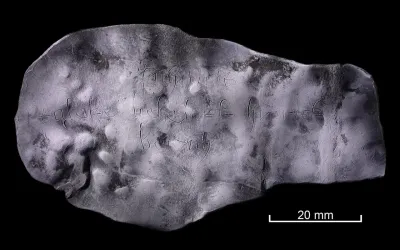 Rostock - According to an announcement by the Rostock City Hall, a devil’s curse tablet dating back to the 15th century has been uncovered in a medieval latrine during construction for the Rostock town hall extension. The inconspicuous rolled-up lead tablet, initially mistaken for scrap, was found at the bottom of the latrine, revealing a Gothic minuscule inscription that reads, “sathanas taleke belzebuk hinrik berith.” This cryptic message directed a devil’s curse against a woman named Taleke and a man named Heinrich (Hinrik). The use of Blackletter, also known as Gothic minuscule or Textura, points to the tablet’s origin between the 12th and 17th centuries. Archaeologists leading the excavation, including Jörg Ansorge from the University of Greifswald, emphasized the exceptional nature of this find, considering that curse tablets are more commonly associated with ancient Greek and Roman periods. Referred to as defixiones in Latin, these lead tablets would be folded or rolled up and hidden in locations believed to serve as gateways to underworld gods who could carry out the curses’ wishes. While curse tablets were prevalent in antiquity, invoking divine or demonic powers for various purposes such as harming rivals, settling disputes, or securing love, the Rostock discovery is unique for its medieval origin. The rarity of such finds from the 15th century adds to the significance of the discovery. The motive behind the curse remains speculative, with researchers suggesting possibilities such as relationship interference, spurned love, jealousy, or a desire to bring misfortune upon the named individuals. The invocation of Beelzebub and Berith adds an extraThe curse tablet was discovered during excavations that unveiled the remains of a 14th-century double-gabled house, described as one of the most beautiful in Northern Germany. The site also revealed traces of cellars and foundations dating to the 16th and 17th centuries, a former waterway, and a 15th-century lusterware blue bowl from Valencia, Spain. layer of intrigue, with Berith being equated with Beelzebub in Rabbinic tradition.
Rostock - According to an announcement by the Rostock City Hall, a devil’s curse tablet dating back to the 15th century has been uncovered in a medieval latrine during construction for the Rostock town hall extension. The inconspicuous rolled-up lead tablet, initially mistaken for scrap, was found at the bottom of the latrine, revealing a Gothic minuscule inscription that reads, “sathanas taleke belzebuk hinrik berith.” This cryptic message directed a devil’s curse against a woman named Taleke and a man named Heinrich (Hinrik). The use of Blackletter, also known as Gothic minuscule or Textura, points to the tablet’s origin between the 12th and 17th centuries. Archaeologists leading the excavation, including Jörg Ansorge from the University of Greifswald, emphasized the exceptional nature of this find, considering that curse tablets are more commonly associated with ancient Greek and Roman periods. Referred to as defixiones in Latin, these lead tablets would be folded or rolled up and hidden in locations believed to serve as gateways to underworld gods who could carry out the curses’ wishes. While curse tablets were prevalent in antiquity, invoking divine or demonic powers for various purposes such as harming rivals, settling disputes, or securing love, the Rostock discovery is unique for its medieval origin. The rarity of such finds from the 15th century adds to the significance of the discovery. The motive behind the curse remains speculative, with researchers suggesting possibilities such as relationship interference, spurned love, jealousy, or a desire to bring misfortune upon the named individuals. The invocation of Beelzebub and Berith adds an extraThe curse tablet was discovered during excavations that unveiled the remains of a 14th-century double-gabled house, described as one of the most beautiful in Northern Germany. The site also revealed traces of cellars and foundations dating to the 16th and 17th centuries, a former waterway, and a 15th-century lusterware blue bowl from Valencia, Spain. layer of intrigue, with Berith being equated with Beelzebub in Rabbinic tradition.
GALLES – 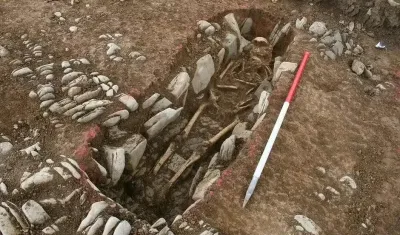 Fonmon - Archaeologists from the universities of Cardiff and Reading have unearthed an extraordinary early medieval cemetery near Fonmon Castle in Wales. Dating back to the sixth and seventh centuries, the site contains around 80 bodies, offering a rare glimpse into the lives of individuals buried around 1,500 years ago. The site has revealed around 80 bodies interred in graves that challenge conventional burial norms. Many skeletons lie flat on their backs, while others are carefully placed on their sides. Strikingly, a significant number of individuals, particularly women, are buried in a crouched position with their knees tucked against their chest—a unique feature not commonly found in other sites from this period. Dr. Andy Seaman, a lecturer in early medieval archaeology at Cardiff University, said: “Sites of this date are extremely rare in Wales and often do not preserve bone and artifacts.” The meticulous excavation process has exposed burial rites that suggest a level of ceremony and differentiation among the individuals buried. All crouched burials are consistently oriented on their right-hand side, facing south, hinting at a coherent cultural or religious practice. The researchers have uncovered more than just human remains, with fragments of glass from Bordeaux and pottery from North Africa providing insights into the privileged status of those buried at Fonmon Castle. Dr. Seaman remarked, “The presence of the important pottery and glass suggests activity of some status and significance.” This notion is further supported by the discovery of metalworking debris and a small bone peg, possibly used in games or as a musical instrument tuning peg.
Fonmon - Archaeologists from the universities of Cardiff and Reading have unearthed an extraordinary early medieval cemetery near Fonmon Castle in Wales. Dating back to the sixth and seventh centuries, the site contains around 80 bodies, offering a rare glimpse into the lives of individuals buried around 1,500 years ago. The site has revealed around 80 bodies interred in graves that challenge conventional burial norms. Many skeletons lie flat on their backs, while others are carefully placed on their sides. Strikingly, a significant number of individuals, particularly women, are buried in a crouched position with their knees tucked against their chest—a unique feature not commonly found in other sites from this period. Dr. Andy Seaman, a lecturer in early medieval archaeology at Cardiff University, said: “Sites of this date are extremely rare in Wales and often do not preserve bone and artifacts.” The meticulous excavation process has exposed burial rites that suggest a level of ceremony and differentiation among the individuals buried. All crouched burials are consistently oriented on their right-hand side, facing south, hinting at a coherent cultural or religious practice. The researchers have uncovered more than just human remains, with fragments of glass from Bordeaux and pottery from North Africa providing insights into the privileged status of those buried at Fonmon Castle. Dr. Seaman remarked, “The presence of the important pottery and glass suggests activity of some status and significance.” This notion is further supported by the discovery of metalworking debris and a small bone peg, possibly used in games or as a musical instrument tuning peg.
MEXIQUE – 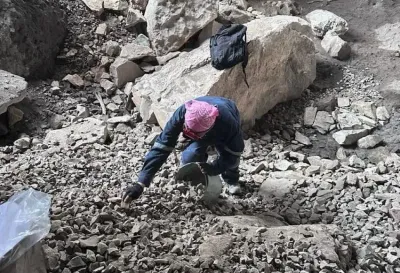 La Morita II - Archaeologists from the National Institute of Anthropology and History (INAH) have made significant discoveries in La Morita II cave, located in the Mexican state of Nuevo León. The excavation, part of the “Prehistory and Historical Archaeology of Northeast Mexico” project initiated in 2003, revealed skeletal remains dating back 2,500 to 3,000 years. The remains, belonging to a baby and two adolescents, were accompanied by fragments of basketry, textiles, and fibers, likely part of funerary bundles. Moisés Valadez Moreno, who serves as the head archaeologist overseeing the excavation, suggested that some infants might have been sacrificed as part of burial rituals. He said: “According to the chronicles, when the mother died during childbirth or minutes later, the infant was sacrificed and accompanied the burial of the deceased.”The sacrificial practices extended to infants with congenital disorders or malformations. Valadez Moreno explained that in cases of twin births, the perceived as a bad omen led to the selection of the healthier infant, while the other was separated and buried alive. This discovery aligns with previous findings, as in 2023, INAH reported uncovering human bone remains, primarily those of children, in La Morita II dating back 3,000 years. The excavations removed approximately 50 square meters of sediment in the main chamber and 24 square meters in the south chamber. Among the 1,500 artifacts found were spearheads, an atlatl, punches, and polished edges, dating from 4,500 to 2,500 years ago. Perishable materials such as cordage and basketry from 3,000 years ago were also unearthed. Valadez Moreno stated: “These latest findings join the almost 30,000 cultural remains recovered in La Morita II.” In addition to the human remains, the cave yielded a diverse range of artifacts. The discoveries included tools for domestic and ritual use, like awls and polished edges, highlighting the versatility of the cave beyond burial purposes. The presence of artifacts like spears and projectile points, along with dried feces and seeds, suggested the cave served as a hub for various daily activities.
La Morita II - Archaeologists from the National Institute of Anthropology and History (INAH) have made significant discoveries in La Morita II cave, located in the Mexican state of Nuevo León. The excavation, part of the “Prehistory and Historical Archaeology of Northeast Mexico” project initiated in 2003, revealed skeletal remains dating back 2,500 to 3,000 years. The remains, belonging to a baby and two adolescents, were accompanied by fragments of basketry, textiles, and fibers, likely part of funerary bundles. Moisés Valadez Moreno, who serves as the head archaeologist overseeing the excavation, suggested that some infants might have been sacrificed as part of burial rituals. He said: “According to the chronicles, when the mother died during childbirth or minutes later, the infant was sacrificed and accompanied the burial of the deceased.”The sacrificial practices extended to infants with congenital disorders or malformations. Valadez Moreno explained that in cases of twin births, the perceived as a bad omen led to the selection of the healthier infant, while the other was separated and buried alive. This discovery aligns with previous findings, as in 2023, INAH reported uncovering human bone remains, primarily those of children, in La Morita II dating back 3,000 years. The excavations removed approximately 50 square meters of sediment in the main chamber and 24 square meters in the south chamber. Among the 1,500 artifacts found were spearheads, an atlatl, punches, and polished edges, dating from 4,500 to 2,500 years ago. Perishable materials such as cordage and basketry from 3,000 years ago were also unearthed. Valadez Moreno stated: “These latest findings join the almost 30,000 cultural remains recovered in La Morita II.” In addition to the human remains, the cave yielded a diverse range of artifacts. The discoveries included tools for domestic and ritual use, like awls and polished edges, highlighting the versatility of the cave beyond burial purposes. The presence of artifacts like spears and projectile points, along with dried feces and seeds, suggested the cave served as a hub for various daily activities.



